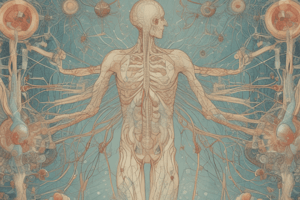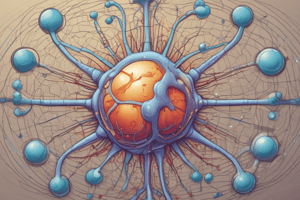Podcast
Questions and Answers
What is the primary therapeutic use of pilocarpine?
What is the primary therapeutic use of pilocarpine?
- Treatment of open-angle glaucoma (correct)
- Bronchial dilation
- Muscle relaxation
- Nausea relief
In what form is pilocarpine typically administered for glaucoma treatment?
In what form is pilocarpine typically administered for glaucoma treatment?
- Sustained-release ocular insert (correct)
- Transdermal patch
- Intravenous injection
- Oral tablets
Which of the following conditions is pilocarpine least likely to treat?
Which of the following conditions is pilocarpine least likely to treat?
- Acute bronchospasm (correct)
- Dry mouth due to Sjögren's syndrome
- Ocular hypertension
- Open-angle glaucoma
Which of the following compounds is NOT a direct-acting muscarinic cholinoceptor agonist?
Which of the following compounds is NOT a direct-acting muscarinic cholinoceptor agonist?
Which two agonists are structurally similar to acetylcholine?
Which two agonists are structurally similar to acetylcholine?
What mechanism does pilocarpine primarily utilize to reduce intraocular pressure?
What mechanism does pilocarpine primarily utilize to reduce intraocular pressure?
What patient population might benefit from pilocarpine's therapeutic effects?
What patient population might benefit from pilocarpine's therapeutic effects?
Which of the following is a direct-acting muscarinic cholinoceptor agonist primarily used for treating dry mouth?
Which of the following is a direct-acting muscarinic cholinoceptor agonist primarily used for treating dry mouth?
What is the common functional characteristic of the listed agonists?
What is the common functional characteristic of the listed agonists?
Which of the following agonists would likely be least effective in mimicking the action of acetylcholine?
Which of the following agonists would likely be least effective in mimicking the action of acetylcholine?
Study Notes
Pilocarpine
- Used for treating open-angle glaucoma, either as eye drops or as a sustained-release ocular insert.
Direct-acting Muscarinic Cholinoceptor Agonists
- Drugs that directly activate muscarinic acetylcholine receptors.
- Examples include: acetylcholine, bethanechol, carbachol, pilocarpine, cevimeline, arecoline and methacholine.
- Bethanechol and carbachol are structurally similar to acetylcholine.
Actions of Direct-acting Muscarinic Cholinoceptor Agonists
- Acetylcholine is broken down by cholinesterases into choline and acetic acid.
- Effects include: diarrhea, increased urination, miosis (pupil constriction), bradycardia, bronchospasm/bronchorrhea, emesis, lacrimation, lethargy, and salivation.
Indirect-acting cholinergic agonists
- Activate muscarinic receptors by inhibiting the enzyme acetylcholinesterase, which breaks down acetylcholine.
- This leads to an accumulation of acetylcholine and prolonged stimulation of muscarinic receptors.
- Adverse effects include: fasciculations, muscle weakness, paralysis, and diaphoresis (excessive sweating).
- Atropine, an anticholinergic agent that competes with acetylcholine at muscarinic receptors, can be used to reverse cholinergic poisoning symptoms.
Studying That Suits You
Use AI to generate personalized quizzes and flashcards to suit your learning preferences.
Related Documents
Description
This quiz covers the pharmacological aspects of direct-acting muscarinic cholinoceptor agonists and their clinical applications, particularly in treating conditions like open-angle glaucoma. It also includes details on their actions, examples, and the effects of indirect-acting cholinergic agonists. Test your knowledge on these important drugs and their mechanisms!




